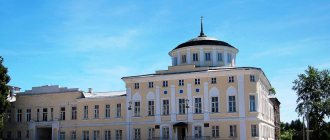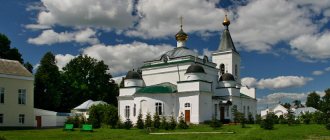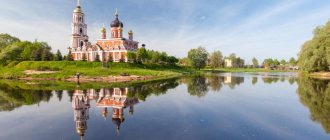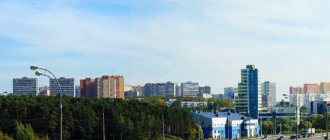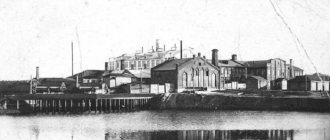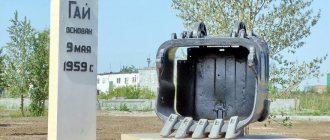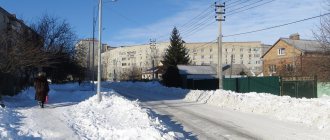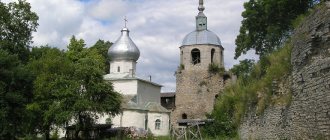Kasimov is a small town in the Ryazan region, which stands on the Oka River in the very center of the Russian Plain. It was founded back in 1152, until 1376 it was called Gorodets Meshchersky, and in 1376-1471. bore the name New Lower City. In addition to the Russian population, representatives of such tribes as the Meshchera, Mordovians and Muroma have long lived in this territory. The sights of Kasimov are as diverse as its history. Below we will introduce you to the most interesting places, attaching descriptions, photos, names and addresses.
The main attractions of Kasimov - TOP-5
Kasimovsky Historical and Cultural Museum-Reserve
- Address - pl. Sobornaya, 7/8.
This museum includes the natural landscape, architectural objects and archaeological relics of the historical center of Kasimov. It is interesting that it was founded here back in 1919, and today its funds already number more than 42 thousand museum objects.
Many of the first employees of the complex were members of the Society of Researchers of the Ryazan Region. In the 1920s the main collections were collected (mainly they were valuables from the estates of the Golitsyns and Olenins, closed churches and monasteries).
In 1928, the museum was closed, and the entire fund was transported to the county department of public education. In 1939, it was located in the building of the former Khan Mosque, at which time it was decided to divide it into two departments - natural and historical.
In 1998, the complex was occupied by a new building - the mansion of the Alyanchikov merchants (19th century). In 2015, it received the status of a museum-reserve.
Today, the Kasimov Museum-Reserve houses a huge collection of paintings and graphics, samples of local crafts (for example, Kasimov bells and clay Vyrkov toys) and traditional clothing.
But the objects of the nobles Golitsyn and Olenin are of particular interest to visitors: household utensils and written sources (manuscripts, private library).
The museum-reserve includes architectural monuments of Cathedral Square, the Kasimov Kremlin and other buildings of the 19th century. In 2017, a permanent exhibition dedicated to the history and ethnography of the Kasimov Tatars opened in the Khan Mosque.
Museum "Russian Samovar"
- Address - st. Sovetskaya, 4.
It is open on all days of the week except Monday - from 10 am to 5 pm. It contains more than 300 samovars, dishes and other accessories for the tea ceremony, as well as some household items.
The museum displays samovars of various types and shapes - a jar, a glass, an acorn, etc. All exhibits are housed in three halls, the most interesting of which is the tea room. Here you can learn about the development and spread of the samovar craft, samovar factories and factories throughout the country.
Kasimov Bell Museum
- Address - st. Ilyushkina, 2/16.
It is available for visiting every day, except Mondays, from 10 am to 5 pm. The Bell Museum was opened to the public in 2014 and is based on the personal collection of Mikhail Silkov, an honorary citizen of Kasimov.
The museum collection includes more than 900 exhibits collected from different parts of Russia, with the help of which you can become familiar with the history of ancient bell making. Among the bells, the predominant ones are Valdai, Slobodsky, Purekh and Kasimovsky (by the way, they are considered the best and most valuable according to collectors).
The museum also contains numerous bells made by local craftsmen - the Kislovs, Skornyakovs, Lenins and Labzenkovs (their autographs can be seen on many items).
Qasim Khan Mosque (another name is Khan Mosque)
- Address - pl. Pobeda, 9A.
The Khan's Mosque is a monument of Tatar architecture for religious purposes. It was built in the 18-19 centuries. in a classical style and is a 2-story building with a dome and a two-tier minaret.
According to information written in Tatar on one of the walls, it began to be built in 1768. Since 1938, the building has been used as a regional museum, and in 2013 it was transferred under the control of the Spiritual Administration of Muslims of the Russian Federation. Today the building of this mosque is included in the list of cultural heritage sites.
Ascension Cathedral
- Address - pl. Sobornaya, 1.
The main cathedral church of Kasimov was erected in 1854 and within a few years it became the most majestic in the city. The Ascension Cathedral is designed in the neo-Russian style by the famous architect Nikolai Voronikhin.
Despite the style direction, Tatar motifs were used in the decorative design of the facades. The cathedral houses the Gospel, printed in 1677, and the icon of John the Baptist. After the revolution, the cathedral was closed, in 1936 the bell tower was equipped with a parachute tower, and in 1960 it was completely dismantled and a sports school for children was placed in the building.
In the 1990s, the Holy Ascension Church was returned to believers, and in 2002 it underwent a major restoration. Now this Kasimov landmark is considered one of the most beautiful churches in the Ryazan region.
Kasimov Center - Sovetskaya Street
Of interest to us, first of all, is the historical center of Kasimov and its attractions. Having arrived at the bus station, it is enough to walk 1.5 kilometers along Sovetskaya Street towards the Oka River to get to your destination.
Sovetskaya Street
You can, of course, get here by bus, but I think you shouldn’t deny yourself the pleasure of a walking tour along the main street of Kasimov.
Kasimov. Stop and public transport.
So, we reached Sovetskaya 27, from this moment the real historical center of Kasimov begins.
Kasimov. View of the city center
On the left side you can see a monument to soldiers who died in local wars and military conflicts.
Fountains, in my opinion, are not very appropriate next to such a memorial.
After examining the monument, you can turn right. A memorial to the Kasimov heroes is located here.
Kasimov. Monument to Heroes
On the right side, Sovetskaya Street intersects with the street. 50 years of the Komsomol. It's actually a very cozy place.
If you come closer to this wooden house. then you can see how sad his condition is.
It’s time to make a museum “Russian Devastation” in Kasimov, and this building will probably be its main attraction.
Another museum exhibit is an example of natural vertical gardening on balconies. Note to the mayor - it looks beautiful from afar and can be made a calling card of the city.
The museum will also feature examples of yard art surrounded by colorful tires.
A little further there is a small square with a monument to Pushkin. Note the original winding flower beds. If you plant flowers in them, it will be a wonderful decoration for the park. So, they are not suitable for our “Museum of Destruction”.
Behind the park on Pushkin Square is the Gazprom building. Against the backdrop of destroyed wooden houses, it looks modern, but I think that the chief architect Kasimova will turn over in his grave if he sees this.
Let's return to Sovetskaya Street. It stretches across the entire city and ends on its northeastern outskirts. The appearance of the central street of Kasimov was formed 100 - 150 years ago, among the architectural styles Empire and Classicism predominate here, the main architect of the buildings is Ivan Sergeevich Gagin.
It must be said that in the historical center of tiny Kasimov the condition of the houses is better than in the almost regional Arzamas. Maybe because this is a modern city center too. The building of the Kasimov Oil and Gas College looks especially good.
In general, if you don’t read the sign with the name, you might think that this is an administration building. True, a balcony without vertical gardening.
Some of the buildings in the center have very beautiful gables.
The architectural frame of the entrance to the building is also interesting.
The creator of most of the architectural monuments of the historical center of Kasimov is the local self-taught enthusiast I.S. Gagin. Look how beautiful it is.
Architectural monument in the center of Kasimov (Gagin)
And an extension was made to this house. Against the backdrop of old architectural monuments, it looks, at a minimum, ridiculous and clearly spoils the overall historical appearance of Kasimov, preserved from the 19th century.
As in any other city, the most popular shops in the center are jewelry. The entrance was beautifully decorated.
But let's return to the architecture of the city. This is the building of the Kasimovsky Technical School of Water Transport, formerly the House of Merchant Smirnov. The location of the city on a large river certainly encourages local residents to dream of distant sea voyages. This is where the water transport technical school comes to the rescue. Now this educational institution has regional status and trains specialists for the Moscow River Shipping Company.
Right in the center of Sovetskaya Street stands the Cathedral of the Ascension of the Lord, built between 1854 and 1862 at the expense of wealthy citizens and designed by Ryazan architect Nikolai Ivanovich Voronikhin. Initially, there was a wooden church on this site, which has not survived to this day.
Cathedral of the Ascension in Kasimov
The most interesting museums and cultural centers
Museum of Unusual Collections
- Address - st. Sovetskaya, 39.
It opened quite recently - in the summer of 2022. It presents an unusual collection of local collector Igor Aleksandrovich Skripay and his relatives. The themes of the collections are extremely wide - here you can see minerals, tea accessories, airplane models, and much more.
The mission of the museum is to awaken people's interest in collecting, especially in collecting unusual things (for example, figurines of certain animals). The attraction is open in Kasimov every day, except Mondays, from 10 am to 5 pm (on Saturday and Sunday - until 15:00).
Palace of Culture
- Address - st. Academician Utkina, 5A.
The cultural center in Kasimov is open every weekday from 8:30 to 18:00. Its modern building was built in 1965, but its history begins much earlier. Currently, 515 people are employed in creative groups, circles and clubs. The best creative teams of the city work here, many of which bear the honorary title “People’s”.
At one time, such famous personalities in domestic star circles as Joseph Kobzon, Mikhail Shufutinsky and Oleg Gazmanov performed on the stage of the Kasimov Palace of Culture. Despite the fact that the building of the attraction needs restoration, the auditorium is well equipped. This can be seen perfectly in the photo.
Tatar Center for Culture and Art named after Ishimbayev
- Address - st. Bolshakova, 31.
The center occupies the building of a former madrasah from the 19th century. It has an exhibition hall where household items, musical instruments and traditional Tatar clothing are displayed. Arabic and Tatar language courses are organized at this Kasimov attraction. All excursions and master classes are conducted by appointment.
Center for Cultural Development
- Address - st. Sovetskaya, 1a.
This center has created all the opportunities for creative self-realization and cultural development, and the emphasis is primarily on family leisure. From time to time, exhibitions are organized where you can see the work of local artists and craftsmen.
The mission of the complex employees is to introduce local residents and guests of the city to traditional crafts. It runs many circles and clubs of various types, for example, there is an applied arts studio, a painting school and a film club.
The city that doesn't exist. "InspektsiYA62" in Kasimov
It was not by chance that we chose Kasimov as the starting point for our “Inspection”. No offense to other Ryazan cities, Kasimov is a special place and very significant for the Ryazan region. So we bought tickets and rushed to the ancient city on the Oka.
However, before “tearing”, the YA62.ru
conducted artillery preparation. Through social networks, the portal’s journalists asked local residents about their problems, made appointments, and planned a walking route around Kasimov. We honestly tried to involve the city administration in our project, but were turned away from the officials. First, the head of the administration’s staff, Elena Kozlova, asked who “authorized us to conduct such inspections,” then persistently asked which local businessman would be our speaker, after which she advised us to make written requests on all the problems that interested us. Well, Elena Vyacheslavovna, according to the criterion “Openness of power to the media” Kasimov gets a solid and well-deserved zero!
Three hours on a well-worn Nizhny Novgorod bus - and now we are already at the Kasimov bus station. We immediately divide into two groups - one goes to communicate with the Kasimovites, the second - consisting of one of the most unsociable journalists from the editorial office - goes to collect their impressions of the city.
No sidewalk
The bus station itself, by the way, is in decent condition; the building does not radiate any decay from the outside or from the inside. The same cannot be said about the main avenue of the city - Sovetskaya Street. Immediately after leaving the station building I come across a complete absence of sidewalks. In general, a further walk showed that Kasimov is a city without sidewalks. Residents on many streets (including central ones) are forced to move along the sides, paths or remnants of what was once called a pedestrian path. The same can be said about trash cans - there is a catastrophic shortage of them in the city. But we’ll talk about the problems of garbage and landfills later.
I make my way along Tatarskaya Street - the problem with the sidewalks here is the same as in the rest of the city. In addition, the weather is not at all happy - a small nasty rain begins, the camera has to be hidden under the jacket.
Now I’m already on the square in front of the administration of the Kasimovsky district - there is a rather neat-looking Kasimov hotel, a post office and several shopping centers. This place doesn't make any impression. But it is here that I meet the first tourist sign and follow it towards the Old Mosque and minaret.
Here my sad mood changes. The mosque and especially the ancient minaret exude indescribable power. By the way, the new mosque, which is located nearby, does not make such an impression.
How do people live here?
According to local residents, they have even begun to get used to the lack of sidewalks over the decades. But what to do if local authorities do not respond to complaints, and all the letters from indignant citizens sent to the regional government go back to Kasimov’s officials?
“There are sidewalks only on the main street,” says native resident Irina Kasimova. “It’s impossible to go outside with a stroller and take a walk: you either walk along the highway and hope that you don’t get hit, or you have to stand near the house.
Of course, Kasimov taxi drivers know the best about the roads. They characterize them exclusively like this: “We have places here where Makar never sent calves!” At the same time, visitors are tactfully asked: “Well, how do you like our roads?”
Vorovskogo Street received a special description, which our team walked along and across. Despite the fact that the navigator shows the road there, it can only be called a direction.
“In spring and autumn there are such puddles here that it is impossible to drive or walk through,” says local resident Daria Frolova. — Sometimes the ambulance doesn’t arrive. And in winter, equipment does not come to us to clear snow. Next to our house there is a building of the local cultural department. So, his employees leave their cars in another place in winter and walk to work.
Trash attraction
Further my path lies along Oktyabrskaya Street. There I meet Kasimov’s “attraction”, which ONF activists were horrified by this spring - huge and smelly garbage dumps in ravines. They are everywhere here. Heaps of garbage are in every Kasimov pit. This, unfortunately, speaks not only about the inaction of officials who have withdrawn themselves from solving the problem, but also about the culture of local residents.
Here, near St. George’s Church, I come across a wonderful sign: “Consecrated Ground. Throwing away garbage is not blessed.” I immediately wanted to appeal to the respected Kasimov clergy: “Please consecrate as much land as possible in Kasimov and do not forget about the ravines!”
I had already reached the final stop of Kasimov bus No. 1 to go to the other end of the city, when a stunning landscape opened up to my eyes: a velvety green slope with a birch grove at the top, a river winding in a ravine, a bridge across it, a church on the mountain and the majestic Oka , complementing the picture on the horizon. Even Kasimov’s constant pile of rubbish underfoot could not contain my admiration. Of course, I forgot about the bus I was going to and went to the church.
The temple itself looks half-abandoned, but the view of Kasimov from it offers excellent views. Gentlemen, Kasimov officials, shouldn’t we make two observation platforms in this area of your wonderful city (one at the end of bus number 1, the other next to the temple) for tourists and build a staircase to the Elias Church, instead of a path along the slope of the ravine?
How do people live here?
It is not always the pig people who are to blame for the fact that garbage is spread across Kasimov in an even layer. There is also a more mundane reason: Kasimov’s people simply have nowhere to throw him away. Vorovskogo Street will again serve as an example for this.
“We have a container, it’s standing,” says Olga Kryuchkova, a resident of house No. 4. - But he is alone and standing at the other end of the street. You just don’t get there every day. And from our side, a garbage truck comes twice a week. If the horn honks, whoever hears it will have time to run out and throw away the bags of garbage - he's lucky. Those who don’t make it in time are left right by the road.
Several more Kasimov residents from other streets confirmed the information about the viability of such a system. From here, the “Inspection” concludes: garbage collection in Kasimov is “smooth, but not very good.”
Outskirts and Central District Hospital
Getting to know the city would be incomplete without visiting the residential area on its outskirts. For this I went to the other side of the Oka to Prioksky. By the way, I was really pleased with the public transport in Kasimov. There are neat, fairly fresh grooves on the lines; minibuses are not visible at all. I made four bus trips in total that day and never waited more than 10 minutes for transport.
The residential microdistrict Prioksky also made a rather positive impression - the village has all the necessary shops, several sports grounds, a football field, a landscaped square and a children's sports school. The only thing that upset me was the condition of the roads in the area. It is clearly below the Kasimov average. True, acquaintance with Kasimov’s most murdered road awaited me ahead.
In the meantime, I’m on my way to the Central Regional Hospital. It also looks neat both outside and inside (judging by the main building). Although the upper floors of the building are in need of repair, there is no trace of the horror that some city Ryazan hospitals evoke here. On the well-groomed territory of the central district hospital there is also a maternity ward, which was clearly built quite recently. Unfortunately (or fortunately), I did not have the opportunity to evaluate the quality of medical care in the hospital, but at first glance the central district hospital in the Kasimovsky district is good.
How do people live here?
The locals don’t say anything bad about their hospitals. Yes, there are queues like everywhere else, yes, there are not enough doctors like everywhere else, but there are no global failures in Kasimov’s healthcare system. On the contrary, Kasimov resident Daria Frolova admitted that she purposefully came to the Kasimov maternity hospital to give birth to a child and does not regret it, since over the past three years the medical institution has significantly improved the quality of services.
The biggest drawbacks locals say are low salaries, lack of personnel and lack of basic consumables in hospitals.
“The salaries are very small,” admits Olga Kryuchkova, who herself works in the healthcare sector. — For nurses it is below the subsistence level. That is why young people are fleeing from Kasimov - there is nowhere to work, it is impossible to earn money.
Residents of Kasimov also confirmed information about a shortage of consumables in hospitals. People are forced to bring their own gloves, bandages and even brilliant green to the appointment.
Shame on Kasimov
It’s time to name the pain points of the city. And the main one is the building of the river station. Abandoned, smelly and overgrown, it welcomes Kasimov’s guests who arrive in the city by river. And to the right of the pier there is an ugly unfinished construction project, which exactly blocks the main Kasimov attractions from tourists.
For a snack, I saved a visit to Kasimov’s deadliest road—Industrialnaya Street. According to local residents, taxi drivers come here only at an increased rate (and they can be understood), and the ambulance sometimes simply “forgets” to come. There is no point in describing this “road”, just look at the photo below.
How do people live here?
The work of Ryazan management companies can safely be considered a separate disgrace and a total disaster for Kasimov. According to local residents, they do absolutely nothing. Of all their responsibilities specified in contracts, management companies only perform garbage removal. We described how they do this at the beginning of the material. People live in dilapidated houses with burned-out wiring, while continuing to pay bills for services that are not even provided to them.
“Our house is quite old, it is a historical monument,” says Olga Kryuchkova. — The wiring constantly sparks and burns out, they don’t want to fix it for us. The management company ZhKO No. 17 offered us to chip in money and replace the wiring ourselves, but they would charge us this as a capital repair bill. Our roof is leaking and falling apart, and our foundation is collapsing. The deadline for major repairs is almost 2035. But we are afraid that the house will simply collapse by this time. Also, when the neighboring house was being demolished, our sewer system was blocked with a bulldozer. We complained to the administration, but they told us that they could not help.
Another scary story with a sequel takes place at the other end of the street. There, an apartment building in which families with children live stands on the edge of a cliff, which crumbles every year.
“In 2016, garages that stood four meters from the edge collapsed into the cliff,” says Daria Frolova. “Then we sounded the alarm.” It’s scary, the house may collapse sooner or later. The management company ZhKO No. 17 told us that this was not their responsibility. We turned to the Kasimov administration so that they could at least help us strengthen the soil near the cliff. It’s just that in our yard there is a sewer collector for a kindergarten located next to the house. It is covered with concrete slabs, on which heavy machines cannot move, otherwise they will simply burst and the collector will break. As a result, we received the following response from the administration:
For more than a year now, the correspondence between the residents of the house on the edge of the cliff and Kasimov’s officials has been going on, but it leads nowhere. People also turned to the government of the Ryazan region for help, but they don’t even look at their problem and send letters back to Kasimov. Meanwhile, the cliff continues to approach the house.
Instead of a conclusion
Kasimov is a wonderful city with huge potential. No wonder it is predicted to become a tourist center. Already today, city guests come here with pleasure to stroll through historical places and admire the sights.
But Kasimov seems cozy, neat and rich only at first glance. It is enough to blink and take your eyes off the domes of the churches to see the complete destruction and disregard of local officials towards the residents of the city. Landfills, dilapidated buildings, ruined roads, lack of sidewalks, low wages, arbitrariness of the authorities and the desire of young people to run away wherever they look - this is the true face of Kasimov. Therefore, before making tourist plans for this once magnificent city, the regional authorities should first show interest and respect for the lives of the locals. Growing roses in a trash heap is, of course, a noble, but thankless task. They will never smell good.
Rating YA62.ru
Team YA62.ru
During his “Inspection” of the cities of the Ryazan region, he will not only describe his impressions and give the floor to local residents to help understand the current situations, but will also compile his own rating of Ryazan cities.
Each city will be assessed according to the following criteria: amenities (cleanliness, roads, amenities), transport, central district hospitals, tourist attractiveness and openness of local authorities to communicate with journalists. For each item, each participant in the “InspectionsYA62” project will give the city its own rating on a 10-point scale, and the share of the “improvement” criterion will be the largest, because all subcriteria, namely cleanliness, roads, amenities, will be considered on an equal basis with other criteria . For each item, the arithmetic mean of the YA62.ru
, and then all the points are summed up.
In the fall of 2022, we will sum up the results and announce the winner of the rating of cities in the Ryazan region according to YA62.ru
.
Kasimov's assessment
Improvement
cleanliness - 5 points ( hereinafter on a 10-point scale
); roads - 4.67 points; amenities (benches, bus stops, sidewalks, trash cans, etc.) - 3.33 points. Result for improvement: 13 points.
Transport
(city transport plus the condition of the bus station) - 7.67 points.
Central District Hospital
— 6 points.
Tourist attraction
(tourism potential and its implementation) - 6.67 points.
Openness of power
— 0 points.
YA62-index
Kasimov is 33.34.
The next stop of the InspektsiYA62 project is in Skopin.
Facts about Kasimov
Date of foundation: 1152. Population: 30,696 people (according to Ryazanstat data for 2016)
. Head of Administration: Mikhail Vasiliev. Distance to Ryazan: 165 km. Bus ticket price to Ryazan: 407 rubles. Public transport fare: 18 rubles.
Photo report on .
Text: Alexander Moiseyuk, Daria Koposova
Photo: Maria Illarionova, Alexander Moiseyuk
Muslim landmarks
New mosque
- Address - st. Narimanov, 20.
Due to the fact that the Qasim Khan Mosque could no longer accommodate the number of Muslim believers who lived in Kasimov, a New Mosque was created in 1906. The initiator of its construction was the merchant Nigmatulla Ibragimovich Duimakaev, who allocated his own plot for construction.
During Soviet times, the building of this Islamic temple was not used for its direct religious purpose, but in 1996 it was again returned to Muslim believers. Today this is the most important mosque of Kasimov, although in terms of beauty, as reviews say, it is still inferior to Qasim Khan.
Tekie (tomb) of Shah Ali Khan
- Address - pl. Victory.
We are talking about a monument of medieval architecture in Kasimov. One of the inscriptions in the tomb says that it was created in 1556. Around this inscription are lines from the Koran in calligraphy.
In 1887, restoration work was carried out here for the first time. At the end of the 19th century, iron doors and fences appeared in the tekie. Now it is a branch of the Kasimovsky Historical and Cultural Museum-Reserve; it is a rectangular white stone 5-meter structure with vaulted brick ceilings and arched openings, made of limestone.
Teki Khan Shah-Ali consists of two rooms - the large one is where the ruler himself and his relatives are buried, and the small one is intended for commemoration and reading the Holy Scriptures of the Muslim Bible.
Tekie of Sultan Afghan Mohammed
- Address - pl. Victory.
The rectangular vaulted tomb made of red brick is located on the Old Posad in Kasimov. The two-chamber mausoleum was erected in 1649 by craftsmen from Ryazan. It is made in the style of traditional Tatar architecture, but the exterior used details of Russian brick patterning, covered with colored glaze.
The main façade is richly decorated and has two windows on the sides, and above the entrance there is an inscription in Arabic indicating the date of death of Afghan-Muhammad (1648).
The place for Tekie Afghan-Muhammad was not chosen by chance, because in the 17th century this was where the Tatar cemetery was located. The mausoleum is amazing because almost 400 years have passed since its construction, but it has retained its original appearance and continues to amaze with its splendor.
Cathedral Park
On the other side of the square is Cathedral Park. A very cozy place where you can escape the sultry summer heat. The park lacks a fountain, benches and flower beds.
Instead of a fountain in the center, there is a foundation stone for the monument to Admiral Avinov.
And instead of flower beds there are weeds. I hope that our “Museum of Devastation” will not receive a new exhibit in the form of this park.
In the park on the side of Sovetskaya Street there is an Obelisk to the fallen Bolsheviks.
The stele is decorated with loud slogans: “We will show the world a new world, labor will be the ruler of the world,” “Proletarians have nothing to lose except their chains. They will gain the whole world."
Orthodox temples and churches
Church of the Assumption of the Blessed Virgin Mary
- Address - pl. Sobornaya, 1a.
The current stone building of this Kasimov church was built in 1775. Before the revolution, the miraculous icon of the Dormition of the Virgin Mary was located here. In 1934 the temple was closed and from 1936 it was used as a library, and from 1939 – as a warehouse. In the 1990s, the parish was returned to believers.
Church of the Annunciation of the Blessed Virgin Mary
- Address - pl. Sobornaya, 13a.
The Annunciation Church was founded in 1740; Kasimov residents consider it the most beautiful religious building in the city. During Soviet times, services were not held here. The Church of the Annunciation was returned to believers in 1994.
Church of St. Nicholas the Wonderworker
- Address - pl. Nikolskaya, 11a.
It was erected in 1705 and has survived to this day. From 1943 to 1990 St. Nicholas Church was the only active Orthodox parish of Kasimov. From pre-revolutionary times, a carved gilded iconostasis of the 18th century remained in it, and there are also 5 icons with pieces of holy relics.
Church of the Life-Giving Trinity
- Address - st. Sverdlova, 1b.
This temple was built in 1753, and in 1772 a stone octagonal bell tower was added to it. Trinity Church is built according to an architectural plan called “octagon on quadrangle”. In 1938 it was closed, placing here first a warehouse and then a workshop for restoration work. In 2002, the temple again began to be used for its religious purpose.
Church of the Epiphany
- Address - st. Oktyabrskaya, 8a.
The Epiphany (St. George) Church is considered the first stone church in Kasimov. It was built back in 1700 in the former Pushkarskaya Sloboda. The architectural style is Baroque. During Soviet times, there was a warehouse for raw hides here, and in 1995 the church opened its doors to believers.
Church of Elijah the Prophet
- Address - st. Okskaya.
This stone temple began to be built in 1811 on the initiative of the merchant Dmitry Semenovich Kakushkin. Construction was completed in 1848, and in 1866 a bell tower appeared at the parish. In 1929, the Elias Church was closed and the building was not used in any way during Soviet times. In 2002, restoration work began, and already in 2003 the church doors were opened to believers. Today, the Temple of Elijah the Prophet is not just an Orthodox landmark of Kasimov, but also a cultural monument of federal significance.
Cathedral (Soviet) Square in Kasimov
Sometimes, in addition to the market square, in the district and provincial towns of Russia a second square arose, above which a beautiful church rose. Among the most interesting squares of this kind is the Cathedral Square of the city of Kasimov. It begins with the Church of the Ascension, which was mentioned above.
Another ancient church building on Sobornaya is the Church of the Assumption of the Blessed Virgin Mary from 1756. The condition is consistent with its age, which is sad.
Church of the Assumption of the Blessed Virgin Mary in Kasimov
The third component of the “spiritual” ensemble of Cathedral Square is the Church of the Annunciation of the Blessed Virgin Mary. Built on the site of one that burned down in 1775.
Among the buildings on the cathedral square, the monumental structure of the former city government looks interesting.
And this is the house of the zemstvo figure Skornyakov, built in the 19th century. Now ordinary people live in this majestic mansion.
There is also a place for market places here. In Kasimov, a monumental complex of commercial premises in the Empire style with classic pediments and colonnades has been preserved. Perhaps even the exemplary trade and warehouse complex of Kostroma does not look so pompous and solemn. The photo shows one of the three buildings of the Kasimov shopping arcade.
Shopping arcades in Kasimov
One of the most beautiful buildings in the “trading” ensemble of the square is the house of the Alyanchikov merchants, built at the beginning of the 19th century. Judging by the scale, it can be assumed that the owner of the mansion was one of the wealthiest residents in the city. Later, the building housed the Kasimov Museum of Local Lore.
Next to these architectural monuments there are ruined houses.
To be honest, the condition of the shopping arcades leaves much to be desired. But they seem to have started to be repaired, which is good news.
If you move a little away from the square, you can see several interesting buildings of Kasimov educational institutions. Here, for example, is a secondary school (the former house of Muromtseva, built at the expense of the Alyanchikovs).
And this house is an architectural monument, which housed a religious school until 1917.
City architectural monuments
House of Ahmed Castrova
- Address - st. Bolshakova, 33.
This architectural monument is located on the territory of the so-called Tatar Settlement. The Castrov merchant family purchased a mansion on the Embankment at the beginning of the 20th century. The owner of the house was Akhmed Khairulovich Kastrov, one of Kasimov’s leading entrepreneurs. After nationalization, during Soviet times, this building housed an orphanage, and then a maternity hospital and a antenatal clinic attached to it. Since 2012, the building has not been used in any way, but is included in the list of cultural heritage sites of the Ryazan region.
Skornyakov's House
- Address - pl. Sobornaya, 15.
A two-story mansion appeared on Kasimov Cathedral Square at the end of the 18th century. It is a stone structure with a balcony with four columns and a wide stone gate. At the top of the facade there is a triangular pediment in the shape of a semicircle. The width of the walls is approximately 1 m. The architectural style is Empire.
The owner of the house, Skornyakov, was a wealthy zemstvo figure. There are legends that many caches and a secret tunnel were hidden inside.
Then the owners of the building changed several times, and since 1914 an infirmary was located here. In Soviet times, in Skornyakov’s house there was a factory dormitory on the first floor, and on the second floor there was a natural science department of the regional museum. Today the building is an ordinary residential building, which, however, does not diminish its beauty.
Kasimovsky shopping arcades
- Address - pl. Sobornaya.
The Kasimov Tatars have long been engaged in trading activities: they sold honey, handicrafts and other goods. In the XVIII-XIX centuries. both Tatars and Russians began to erect buildings for trade. They were rectangular brick one-story structures.
In Kasimov there were several shopping arcades that belonged to Tatar merchants. And although almost all of them are now privately owned, they still remain striking architectural objects that characterize the everyday culture of the Kasimov Tatars.
Where to go with children in Kasimov
Museum of Translator Anna Hansen
- Address - st. Nikolsky ravine, 1.
Here, by appointment, excursions are regularly organized, including for children - with elements of theatrical performance and tea drinking. The idea of opening such an establishment belongs to Kasimov local historian A.N. Smirnov, who dreamed of introducing city guests to the life of Anna Hansen, a translator of the books of the famous children's writer Hans Christian Andersen. Among the exhibits you can see “galoshes of happiness”, tin soldiers and other items related to Andersen’s work.
Apartment-museum “Butterflies and dragonflies”
- Address - pl. Sobornaya, 10a.
Like the Museum of Unusual Collections, the Collection of Butterflies and Dragonflies is an initiative of Igor Skripai. A local collector began collecting butterflies as a child, but his collection includes more than just real insects. Here you can see a collection consisting of jewelry, paintings, stamps, boxes and even fossil fragments with butterflies and dragonflies. The establishment is popular not only among local residents, but also among tourists from other Russian cities and foreign countries. The attraction is especially delightful for children.
Don't miss the sights in Skopin, Gus-Zhelezny, Spas-Klepiki and Ryazan.
The city of Kasimov is interesting from a historical and cultural point of view. It is usually visited by tourists interested in the culture and history of the Ryazan region and all of Russia as a whole. Moreover, in 2015 Kasimov was included in the list of tourist routes “Golden Ring of Russia”. First of all, city guests strive to see medieval Muslim architecture, Orthodox churches and unusual local museums, which we told you about by showing the sights of Kasimov in the photo.
Embankment in Kasimov
Having finished exploring the park and square, you can go to the embankment by going down Ryazansky Spusk Street.
Judging by the photographs from the network, just a few years ago it was intact, but soon in winter it will be possible to make an ice slide out of it with a descent into the Vukhukhlevsky kingdom. Some local residents already prefer to go down the roadway.
But the pain is worth it. Before us is the most beautiful part of the city - the Oka embankment.
Its main attraction is the Petrovskaya Zastava, named after Peter I. It was through this entrance that the Great Tsar of All Rus' arrived here by water. During the time of Peter I, the outpost served as a security point and fence of the city.
The boat decorating the embankment is a symbol of the city and a reflection of its main dignity.
The embankment, like the center of Kasimov, also has interesting architecture. For example, here is an architectural monument of federal significance - the Barkov House (early 19th century) in the Empire style. It is known that in this house there were rooms specially equipped for the rest of the future Emperor Alexander II, who visited Kasimov while traveling around Russia in 1837. The main hall was decorated in marble.
But a building in a more classical style is the Shemyakin House. This bright mansion now houses a notary's office.
In general, the urban development of Kasimov is impressive. Even on the embankment, an abundance of old mansions has been preserved, and all of them are beautiful and interesting.
By the way, Kasimov has a river port, which is the main tourist gate of the city, as it often receives guests of popular river cruises. We saw a lot of ships and boats on the Oka River; you rarely see this in Murom.
And here is a view of the bridge over the Oka.
Fishing garages are scattered along the entire river bank.
Our journey through the city has ended. Unfortunately, today we did not reach the Tatar Kasimov. Of interest are the Khan's cathedral mosque, the museum that is located there, the Tekie of Shah Ali Khan, the Tekie of Avgan Mohammed Sultan, the Tekie dungeon, the entrance sign to Kasimov in the Tatar language and the victory memorial located in the Tatar quarter. We'll leave that for the next city tour.
